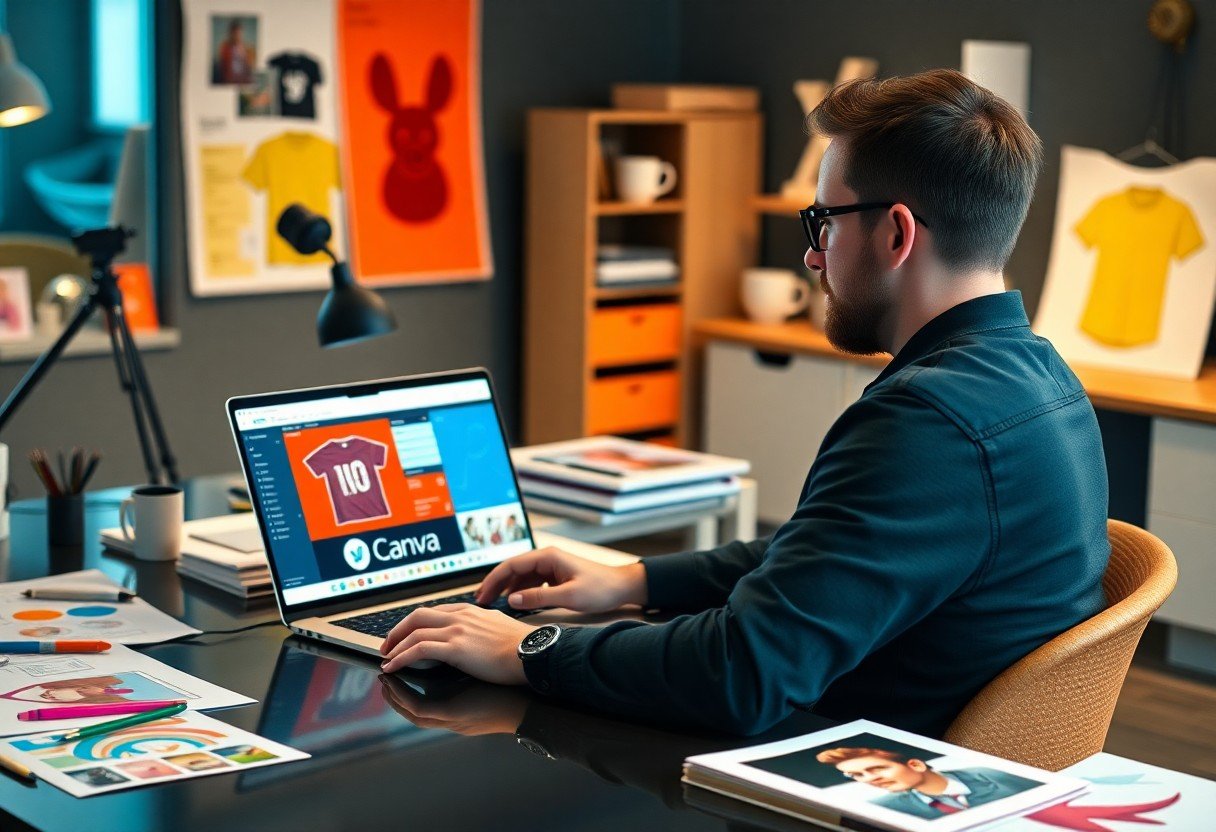With my experience in the creative industry, I have discovered how Canva serves as a powerful tool for instant merch design. In this post, I will share how I harness its features to create eye-catching designs that resonate with my audience. By utilizing Canva’s user-friendly interface, I can swiftly turn ideas into market-ready merchandise and enhance my brand’s visibility. Join me as I explore the tips and strategies that make Canva an vital part of my design process.
Unpacking Jesper Jacobi’s Design Philosophy
My design philosophy revolves around connecting with audiences through engaging visuals while ensuring usability in every piece I create. This synergy between art and purpose defines my approach, guiding me to craft solutions that resonate emotionally and contextually with buyers. By embracing a mindset that prioritizes both innovation and practicality, I strive to bridge the gap between the extraordinary and the achievable in my merch designs.
The Intersection of Creativity and Functionality
Finding that sweet spot between creativity and functionality is necessary in my work. I aim to create designs that not only capture attention but also serve a purpose, making them appealing from both aesthetic and practical viewpoints. This dual focus ensures my merch resonates well with consumers while meeting their needs.
Balancing Aesthetics with Market Trends
Integrating current market trends with compelling aesthetics is a balancing act I enjoy mastering. My designs evolve to reflect what is popular while maintaining a unique edge that keeps them fresh and relevant.
The landscape of consumer preferences is constantly shifting, and staying ahead requires a keen observation of what’s trending. I spend time analyzing social media, industry reports, and fashion forecasts to dive deeper into color palettes, patterns, and themes that are gaining traction. This research not only informs my design direction but also encourages me to infuse my distinct style into contemporary trends. This way, I am able to produce merch that captivates an audience while ensuring that it remains relevant in a competitive market, effectively merging personal artistry with popular demand.
The Mechanics of Merch Design with Canva
Canva has revolutionized my approach to merchandise design, turning complex processes into user-friendly workflows. With its intuitive interface, I can easily create compelling visuals that resonate with my audience. The flexibility of customizable templates and extensive design tools allows me to experiment and refine my ideas quickly, ensuring each piece reflects my brand’s identity and ethos.
Navigating Canva’s Features for Merch Success
Canva offers a wealth of features tailored for merch design, making it simple to navigate through various elements. From a vast library of images, icons, and fonts to the ability to collaborate in real time, I can craft unique designs effortlessly. Adjusting layers, backgrounds, and color schemes becomes a seamless process, allowing me to focus on creativity rather than technical difficulties.
Streamlined Graphic Creation for Instant Results
The speed and efficiency of creating graphics in Canva are unmatched. I can churn out designs in mere minutes, which is important when I have tight deadlines or last-minute ideas. The drag-and-drop functionality paired with ready-made templates significantly reduces the time from concept to finished product, enabling me to maximize my merch offerings.
Designing graphics with Canva transforms a once time-consuming process into an enjoyable creative endeavor. The platform’s ability to swiftly generate professional-quality designs means I can respond to trends and audience demands without delay. With the option to download in various formats, I can prepare files for printing in no time, ensuring that my merchandise is not only visually appealing but also market-ready in an instant.
Real-time Design Strategies: Jesper’s Approach
In the fast-paced world of merch design, real-time strategies are vital for keeping up with trends and meeting customer demands. I rely on Canva’s user-friendly interface to create and modify designs on the fly. This approach allows me to respond to audience feedback instantaneously, ensuring that my products resonate with their preferences. By embracing a fluid design process, I can swiftly adjust elements such as color palettes or typography to maintain fresh, engaging visuals that never go stale.
Leveraging Templates for Rapid Production
Using Canva’s extensive library of pre-designed templates significantly accelerates my design workflow. I can select an appropriate template and customize it quickly, cutting down the time needed to create merch from scratch. This not only enhances efficiency but also gives me access to a wide variety of design styles that ensure my creations remain trendy and appealing.
Customization Techniques That Stand Out
Crafting unique designs doesn’t have to be time-consuming. I utilize various customization techniques to enhance my designs, such as adjusting color schemes, layering images, and incorporating custom graphics. This not only personalizes my products but also makes them distinctive in a crowded market. My goal is to create merch that not only reflects my brand identity but also captivates my audience.
To elevate my differentiation game, I focus on integrating unique elements like handmade illustrations or personal typography that speaks directly to my audience. By pairing trending colors with bespoke graphics, I develop a signature style that stands out in the marketplace. Plus, I frequently experiment with textures and backgrounds in Canva to add depth, ensuring each piece offers something novel. This blend of personal touch and timely adaptation positions my merchandise as both trendy and authentic.
Marketing Merch Through Visual Design
Visual design plays an vital role in marketing merchandise, creating a memorable brand presence that resonates with your audience. I focus on utilizing unique visuals that capture attention while conveying the essence of the brand in a single glance. By leveraging design principles and Canva’s array of templates, I ensure that each piece of merch is not just an item for sale, but a conversation starter that aligns with my brand’s message and values.
The Power of Cohesive Branding
The beauty of cohesive branding lies in its ability to create a seamless experience for the consumer. I utilize consistent colors, fonts, and graphics across all merchandise, making it recognizable and reliable. This unity not only strengthens brand identity but also cultivates trust and loyalty among my audience, encouraging them to support the brand repeatedly.
Engaging Audience through Visual Storytelling
Visual storytelling is a powerful strategy that I employ to forge deeper connections with my audience. Instead of just selling products, I share stories through imagery and design, allowing customers to relate to the narrative behind the merchandise. This type of connection transforms a simple product into a representation of shared values and experiences, encouraging more meaningful purchases.
For instance, when I design a new item, I think beyond its aesthetic appeal. By illustrating the backstory, mission, or emotions connected to the design, I create a narrative that resonates with potential buyers. This storytelling approach not only makes the merchandise feel more personal but also fosters community engagement, leading to a loyal fanbase eager to spread the word and share their own stories related to the brand.
Lessons from Jesper’s Canvas: Tips for Aspiring Designers
Drawing inspiration from Jesper’s journey in using Canva for rapid merch design, aspiring designers can benefit from a variety of techniques. Always keep your design process simple and focused for a stronger visual impact. Experiment with different templates and layouts to find what resonates with your audience. Leverage the extensive graphics library to unleash your creativity. Be open to feedback—iteration is key in evolving as a designer. Collaboration with peers may lead to more innovative ideas and approaches. Assume that each design is a step towards mastering your craft.
Common Pitfalls and How to Avoid Them
A common trap for new designers is overcomplicating their designs with too many elements. This not only confuses the viewer but also dilutes the message. Focus on a clear, strong concept and stick to it. Cluttered visuals can lead to weaker brand identity; therefore, always aim for a balance between aesthetics and functionality. I learned to prioritize readability and impact, ensuring that every design element serves a purpose.
Essential Tools to Enhance the Design Process
While Canva is an excellent starting point, incorporating other tools can significantly enhance your design workflow. Software like Adobe Photoshop or Illustrator allows for more advanced editing and manipulation of visuals, offering greater flexibility in your designs. Utilizing plugins for Canva can also increase efficiency, helping you access additional graphics, templates, and functionalities.
Beyond traditional tools, consider using productivity apps like Trello or Asana to manage your design projects effectively. They help keep your workflow organized and ensure that deadlines are met. Additionally, platforms like Unsplash and Pexels are fantastic sources for high-quality stock images. Expanding your toolkit enables you to transform your ideas into polished designs much faster than relying solely on one platform.
To wrap up
Considering all points, my exploration of how Jesper Jacobi uses Canva for instant merch design reveals the platform’s versatility and user-friendly interface. By harnessing Canva’s extensive templates and design tools, I can create visually appealing merchandise that resonates with my audience quickly and efficiently. This empowers you to elevate your brand’s presence and streamline your creative process, making it easier than ever to launch new products. Overall, I’ve found Canva to be an invaluable resource in transforming my design ideas into reality without sacrificing quality or creativity.
FAQ
Q: What is Jesper Jacobi’s approach to using Canva for instant merch design?
A: Jesper Jacobi leverages Canva’s user-friendly interface and extensive template library to create eye-catching merchandise designs quickly. He often starts with a template that aligns with his vision and modifies it by incorporating his branding elements, colors, and custom graphics. This approach allows him to produce professional-quality designs without the need for advanced graphic design skills.
Q: What types of merchandise does Jesper design using Canva?
A: Jesper designs a variety of merchandise using Canva, including t-shirts, mugs, stickers, and posters. He finds that Canva’s versatility enables him to adapt each design to different products seamlessly, ensuring that all his merchandise reflects his unique style and messaging.
Q: How does Jesper ensure the quality of his designs when using Canva?
A: Jesper maintains high design quality by utilizing Canva’s high-resolution export options, ensuring that his images are suitable for print. He also pays attention to the dimensions recommended for each type of merchandise, taking advantage of Canva’s guides and tools to help him create designs that look polished and professional in the final product.
Q: Does Jesper use any specific features in Canva to enhance his designs?
A: Yes, Jesper makes good use of Canva’s extensive library of graphics, fonts, and animations. He often incorporates unique elements like custom illustrations and icons that resonate with his target audience. Additionally, he takes advantage of features like layering and transparent backgrounds to create depth in his designs, allowing them to stand out.
Q: How does Jesper promote his merchandise designs created with Canva?
A: Jesper promotes his merchandise through social media platforms and his online store. He often shares behind-the-scenes glimpses of his design process on platforms like Instagram and TikTok, showcasing the finished products and the stories behind them. He also uses Canva to create promotional graphics and ads that attract customers by emphasizing the unique aspects of his merchandise.




